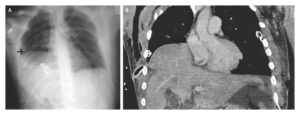This post is an answer to the Case – Patient with blurry vision, headache, and difficulty looking upward
Pupils only minimally constricted to light but constricted to near objects is a finding known as light–near dissociation. Pupillary light–near dissociation is characterized by the absence of constriction to light with an intact accommodation reflex.
Causes of light–near dissociation include dorsal rostral midbrain lesions, as in this case, and neurosyphilis, though the Argyll Robertson pupils associated with syphilis are also typically miotic and irregular at baseline.

Magnetic resonance imaging of the brain showed an enhancing dorsal midbrain and medial thalamic lesion with obstructive hydrocephalus. After noninvasive testing did not confirm the diagnosis, ventriculostomy and biopsy of the lesion were performed, and histologic analysis showed a nonsecreting germinoma.
The patient was treated with platinum-based chemotherapy followed by radiation, which resulted in complete resolution of the lesion. At 1-year follow-up, his pupillary responses were normal to both light and accommodation; however, he had persistent diplopia and disconjugate gaze.

